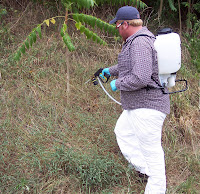Forests are not exempt from the ongoing financial crisis. Pennsylvania's forest products industry clearly links to the general state of the economy as lumber, furniture, components, and cabinets depend on housing starts. Most wood-related mills in Pennsylvania have reduced or closed operations.
As an indicator of how bad things are, visit Penn State's Timber Market Report at
http://www.sfr.cas.psu.edu/TMR/TMR.htm. Stumpage prices for most species are less than half what they were a few years ago. Across the US and globally, the state of the forest products industry is similar. The good news is that there are signs of recovery -- albeit slow. Experts predict a year or so before we are, pardon the pun, out of the woods.
While the economy is down there are emerging opportunities such as bioenergy, natural gas, and carbon offsets. High energy prices in 2007/2008 sparked interests in renewable energy and the potential of woody biomass as a viable alternative for heating, power, and ultimately ethanol (gas). The newfound interest in the Marcellus natural gas shale formation, underlying two-thirds of Pennsylvania, is another income opportunity for thousands of forest landowners. As the US Congress is poised to address the climate bill, forest landowners are in line to capture income from selling carbon credits to polluters. These emerging opportunities are not without risk, and caution is the operative word as these alternatives evolve.
Any decision a landowner makes, whether it is harvesting, reforesting, fencing, selling carbon credits, or gas leasing, has tax implications. As most people are pinching pennies, every taxable dollar saved from Uncle Sam is a dollar earned. With little effort, there are numerous ways forest landowners can take advantage of incentives and deductions provided by the IRS. Every forest landowner should know about concepts such capitalization (establishing basis), deductions/expenses, capital gains, reforestation tax incentives, cost share programs exclusions, and conservation easements.
What does the current economic outlook and emerging markets mean for forest owners, forestry professionals, and industry? First it suggests landowners need good timely advice on their options so as to make wise decisions about their property and resources. Forestry professionals and their advisors (e.g., accountants, financial advisers, attorneys, etc.) need up-to-date information about the forest economy.
In October and early November, Penn State Natural Resources Extension is offering workshops throughout the state on forest taxes, forest finance, and estate planning. All the above mentioned issues and more will be discussed. You can find information on the forest taxes and finance meetings at:
http://rnrext.cas.psu.edu/pdfs/TaxFinance2009.pdf. Information on the estate planning sessions in Mercer County can be found at:
http://rnrext.cas.psu.edu/pdfs/2009ForestEstatePlanningFinal.pdf.
Written by: Dr. Michael Jacobson for the Forest Stewardship news release 9-16-09.
 Woodland Owners Associations (WOAs) are excellent resources for landowners. Landowner associations provide an opportunity to fellowship with other landowners. They also provide educational information including presentations, tours, and other educational opportunities. WOA's provide an opportunity to network with your peers – other private forest landowners. For a new landowner or if you are not quite sure where to start on a particular project, members of a WOAs can be a great place to start asking questions. You can get to know other landowners in your region, get recommendations on natural resource professionals, and attend talks on subjects of interest to you. Many WOAs are currently located throughout the state and new ones continue to form. With a total of 27, associations can be found in almost every county. (Forest leaves, Summer 2009)
Woodland Owners Associations (WOAs) are excellent resources for landowners. Landowner associations provide an opportunity to fellowship with other landowners. They also provide educational information including presentations, tours, and other educational opportunities. WOA's provide an opportunity to network with your peers – other private forest landowners. For a new landowner or if you are not quite sure where to start on a particular project, members of a WOAs can be a great place to start asking questions. You can get to know other landowners in your region, get recommendations on natural resource professionals, and attend talks on subjects of interest to you. Many WOAs are currently located throughout the state and new ones continue to form. With a total of 27, associations can be found in almost every county. (Forest leaves, Summer 2009)




























 PA GAME LANDS Deer Habitat & Management Tour
PA GAME LANDS Deer Habitat & Management Tour







